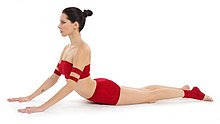Bhujangasana

Bhujangasana (Sanskrit: भुजंगासन; IAST: Bhujaṅgāsana) or Cobra Pose[1] is a reclining back-bending asana in hatha yoga and modern yoga as exercise.[2] It is commonly performed in a cycle of asanas in Surya Namaskar (Salute to the Sun) as an alternative to Urdhva Mukha Svanasana (Upwards Dog Pose).
Etymology and origins[]

The name comes from the Sanskrit words भुजंग bhujaṅga, "snake" or "cobra" and आसन āsana, "posture" or "seat", from the resemblance to a cobra with its hood raised and was described in the 17th century hatha yoga text Gheranda Samhita in chapter 2, verses 42-43. In the 19th century Sritattvanidhi, the pose is named Sarpasana, which similarly means Serpent Pose.[3]
Description[]

The pose may be entered from a prone position or from Downward Dog. The palms are placed under the shoulders, pushing down until the hips lift slightly. The backs of the feet rest on the ground, the legs outstretched; the gaze is directed forwards, giving the preparatory pose. For the full pose, the back is arched until the arms are straight, and the gaze is directed straight upwards or a little backwards. The legs remain on the ground, unlike in the similar Upward Dog pose.[4]
Bhujangasana is part of the sequence of yoga postures in some forms of Surya Namaskar, the Salute to the Sun.[5]
Variations[]

An easier variant is Sphinx Pose, sometimes called Salamba Bhujangasana (षलम्ब भुजंगासन),[6] in which the forearms rest on the ground, giving a gentler backbend.[7] It is used in the long holds of Yin Yoga, either with the forearms on the ground or with the arms straightened.[8]
Advanced practitioners may fold the legs into Padmasana (lotus).[8]
The pose can be modified, for instance, in pregnancy, by placing a blanket under the pelvis.[8]
See also[]
- List of asanas
- Urdhva Mukha Shvanasana, Upwards Dog pose, a similar reclining backbend
References[]
- ^ YJ Editors (28 May 2007). "Cobra Pose". Yoga Journal.
- ^ How To Do Cobra Pose https://www.verywell.com/cobra-pose-bhujangasana-3567067
- ^ Sjoman, Norman E. (1999) [1996]. The Yoga Tradition of the Mysore Palace (2nd ed.). Abhinav Publications. p. 71. ISBN 81-7017-389-2.
- ^ Iyengar, B. K. S. (1979) [1966]. Light on Yoga. Schocken. pp. 107–108, 396–397. ISBN 0-8052-1031-8.
- ^ "Surya Namaskara". Divine Life Society. 2011. Retrieved 19 July 2019.
- ^ "Sphinx Pose -Salamba Bhujangasana". Ekhart Yoga. Retrieved 4 February 2019.
- ^ YJ Editors (28 August 2007). "Sphinx Pose". Yoga Journal. Retrieved 4 February 2019.
Sphinx Pose is the infant of backbends.
- ^ a b c "Sphinx & Seal". Yin Yoga. Retrieved 26 July 2019.
Sources[]
- Iyengar, B. K. S. (1979) [1966]. Light on Yoga: Yoga Dipika. Unwin Paperbacks. ISBN 978-1855381667.
- Jain, Andrea (2015). Selling Yoga : from Counterculture to Pop culture. Oxford University Press. ISBN 978-0-19-939024-3. OCLC 878953765.
- Newcombe, Suzanne (2019). Yoga in Britain: Stretching Spirituality and Educating Yogis. Bristol, England: Equinox Publishing. ISBN 978-1-78179-661-0.
- Backbend asanas
- Medieval Hatha Yoga asanas


